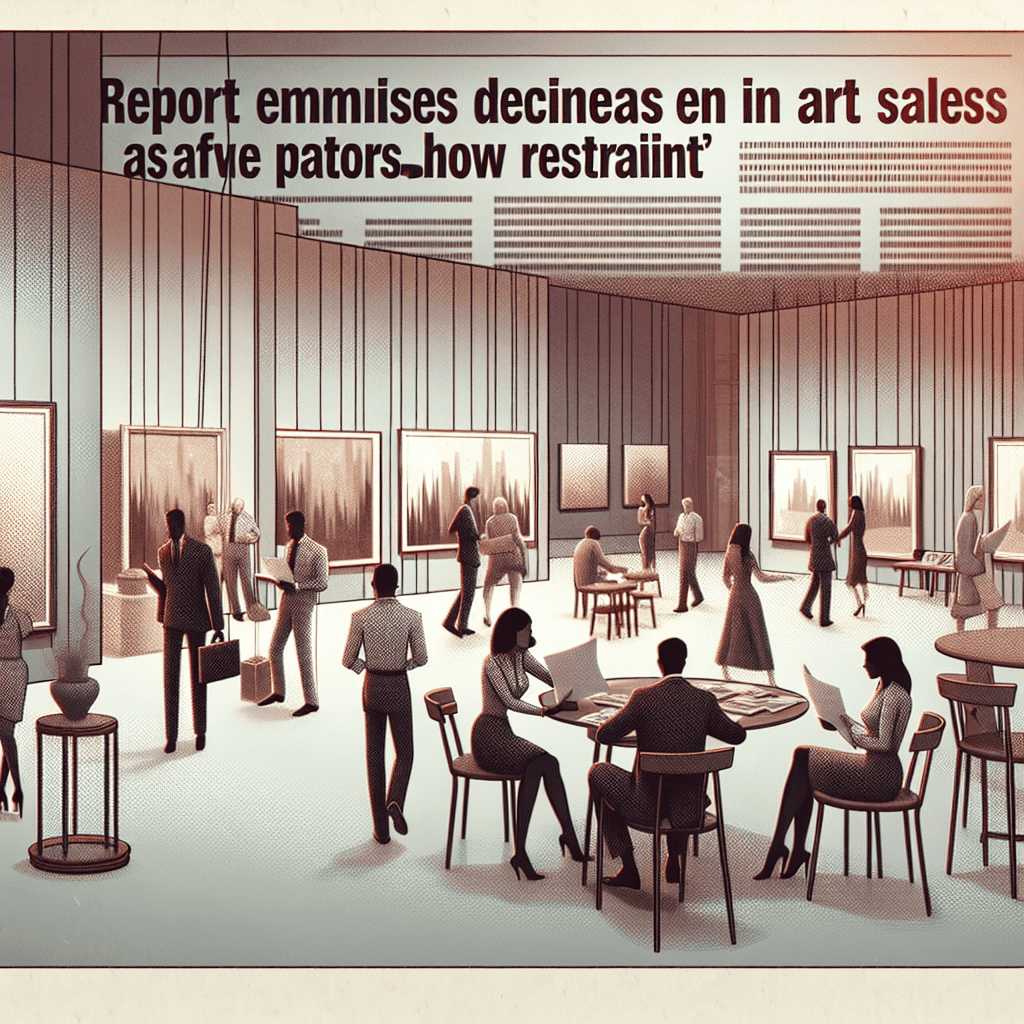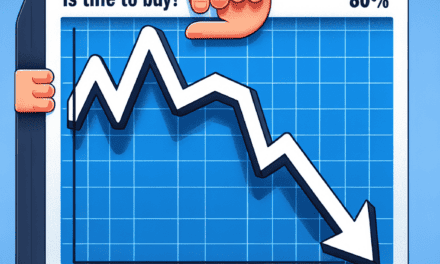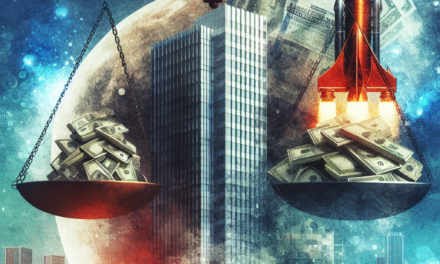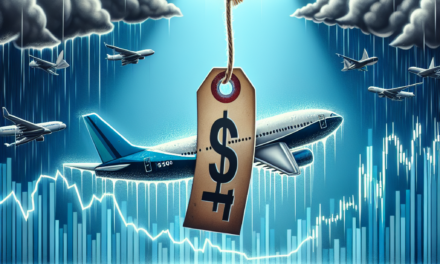“Art Market Cools: UBS Report Reveals Wealthy Buyers Hit Pause on Purchases”
Introduction
The UBS Report has recently highlighted a notable decline in art sales, reflecting a cautious approach among wealthy clients amid economic uncertainties. This trend underscores a shift in the art market dynamics, where affluent collectors are exhibiting restraint in their purchasing decisions. The report delves into the factors contributing to this downturn, including global financial volatility and changing investment priorities among high-net-worth individuals. As the art market navigates these challenges, the report provides valuable insights into the evolving landscape and the strategic considerations of art investors in the current economic climate.
Impact Of Economic Uncertainty On Art Market Trends
The recent UBS report has shed light on a notable decline in art sales, attributing this trend to the cautious behavior of wealthy clients amid prevailing economic uncertainties. As the global economy grapples with fluctuating markets, inflationary pressures, and geopolitical tensions, affluent collectors are exhibiting a more conservative approach to art investments. This shift in behavior is not only impacting the volume of transactions but also influencing the types of artworks that are being sought after in the market.
To begin with, the art market has historically been perceived as a stable investment avenue, often considered a safe haven during times of economic volatility. However, the current economic landscape presents a unique set of challenges that are prompting even the most seasoned collectors to reassess their strategies. The UBS report highlights that the decline in art sales is not merely a reflection of reduced purchasing power but also a strategic decision by wealthy clients to preserve liquidity. In times of uncertainty, maintaining cash reserves becomes a priority, leading to a more selective approach to art acquisitions.
Moreover, the report underscores a shift in the types of artworks that are garnering interest. While contemporary and modern art have dominated the market in recent years, there is now a discernible pivot towards classic and historically significant pieces. This trend suggests that collectors are seeking stability and long-term value, opting for artworks with established provenance and historical importance. Such pieces are perceived as less volatile and more likely to retain their value over time, providing a sense of security in an unpredictable economic environment.
In addition to changing preferences, the report also points to the role of digital platforms in shaping current art market trends. The pandemic accelerated the adoption of online sales channels, and while this has broadened access to art markets, it has also introduced new dynamics. Digital platforms offer transparency and convenience, yet they also expose buyers to a wider array of choices, potentially overwhelming those who are already cautious. Consequently, the decision-making process has become more deliberate, with buyers taking additional time to research and verify the authenticity and value of artworks before committing to a purchase.
Furthermore, the UBS report highlights the influence of geopolitical factors on the art market. Trade tensions and regulatory changes can impact cross-border transactions, adding another layer of complexity for international collectors. As a result, some buyers are opting to focus on local markets, where they perceive fewer risks and greater familiarity. This localized approach may contribute to regional disparities in art sales, with certain markets experiencing more pronounced declines than others.
In conclusion, the decline in art sales as highlighted by the UBS report is a multifaceted issue driven by economic uncertainty, shifting buyer preferences, and the evolving role of digital platforms. Wealthy clients are exercising caution, prioritizing liquidity, and gravitating towards artworks that offer stability and long-term value. As the global economy continues to navigate these turbulent times, the art market is likely to experience further adjustments, with collectors and investors remaining vigilant and strategic in their approach. The interplay of these factors will undoubtedly shape the future landscape of the art market, influencing both the supply and demand dynamics in the years to come.
Wealthy Collectors’ Shift In Investment Strategies
The recent UBS report has shed light on a notable decline in art sales, a trend that has captured the attention of wealthy collectors and art market analysts alike. This downturn is attributed to a growing sense of caution among affluent clients, who are increasingly reevaluating their investment strategies in response to global economic uncertainties. As the art market has long been considered a barometer of economic confidence, this shift in purchasing behavior signals a broader trend among the wealthy to exercise prudence in their financial decisions.
In recent years, the art market has experienced significant fluctuations, driven by a combination of geopolitical tensions, fluctuating currency values, and evolving consumer preferences. These factors have collectively contributed to a more cautious approach among high-net-worth individuals, who are now prioritizing financial stability over speculative investments. The UBS report highlights that this shift is not merely a temporary reaction to current market conditions but rather a strategic realignment of investment priorities.
Moreover, the report underscores the impact of technological advancements on the art market, which have facilitated greater transparency and accessibility. Online platforms and digital auctions have democratized the art-buying process, allowing collectors to make more informed decisions. However, this increased access to information has also led to heightened scrutiny and due diligence, as buyers are now more aware of the potential risks associated with art investments. Consequently, wealthy collectors are becoming more discerning, opting for works with established provenance and historical significance rather than speculative contemporary pieces.
Furthermore, the UBS report indicates that the decline in art sales is not uniform across all segments of the market. While contemporary art has seen a noticeable dip in demand, other categories, such as Old Masters and Impressionist works, have maintained their appeal among collectors. This trend suggests a shift towards more traditional and historically significant pieces, which are perceived as safer investments in uncertain times. The preference for these time-tested artworks reflects a broader desire among wealthy clients to preserve their wealth through tangible assets that have demonstrated resilience over the years.
In addition to these market dynamics, the report also highlights the role of art advisors and financial consultants in shaping the investment strategies of affluent clients. As the art market becomes increasingly complex, wealthy collectors are relying more on expert guidance to navigate the intricacies of art acquisition and management. These professionals provide valuable insights into market trends, helping clients to identify opportunities and mitigate risks. This collaborative approach underscores the importance of informed decision-making in the art investment landscape.
In conclusion, the UBS report offers a comprehensive analysis of the current state of the art market, emphasizing the cautious stance adopted by wealthy collectors in response to economic uncertainties. This shift in investment strategies reflects a broader trend towards financial prudence and risk management, as affluent clients seek to safeguard their wealth in an unpredictable global environment. As the art market continues to evolve, it will be crucial for collectors and advisors alike to remain vigilant and adaptable, ensuring that their investment decisions align with both market conditions and long-term financial goals.
UBS Report: Key Insights Into Art Sales Decline
The recent UBS report has brought to light a notable decline in art sales, a trend that has captured the attention of collectors, investors, and market analysts alike. This downturn is particularly significant as it reflects broader economic uncertainties and shifting priorities among wealthy clients. The report meticulously outlines the factors contributing to this decline, offering a comprehensive analysis that underscores the cautious approach adopted by affluent buyers in the current market climate.
To begin with, the report highlights that the art market, traditionally seen as a stable investment avenue, is experiencing a slowdown due to a confluence of economic pressures. These include fluctuating global markets, geopolitical tensions, and the lingering effects of the COVID-19 pandemic, which have collectively fostered an environment of caution among high-net-worth individuals. As a result, these clients are increasingly hesitant to make substantial investments in art, opting instead to preserve liquidity and minimize risk.
Moreover, the UBS report points to a shift in the investment strategies of wealthy clients, who are now prioritizing assets with more predictable returns. This shift is partly driven by the volatile nature of the art market, where prices can be highly unpredictable and subject to sudden changes in taste and demand. Consequently, many affluent buyers are redirecting their funds towards more traditional investment vehicles such as stocks, bonds, and real estate, which offer greater stability and transparency.
In addition to economic factors, the report also delves into the evolving tastes and preferences of art collectors. There is a growing emphasis on contemporary and digital art, which, while popular, often lacks the historical value and established market presence of classical works. This trend has led to a fragmentation of the market, with buyers becoming more selective and discerning in their acquisitions. The rise of digital art, including NFTs (non-fungible tokens), has introduced a new dynamic, attracting a younger demographic but also adding complexity to the market landscape.
Furthermore, the report underscores the impact of regulatory changes and increased scrutiny on art transactions. Governments worldwide are implementing stricter regulations to combat money laundering and ensure transparency in high-value transactions. These measures, while necessary, have added layers of complexity to the buying process, potentially deterring some clients from engaging in art purchases.
Despite these challenges, the UBS report remains cautiously optimistic about the long-term prospects of the art market. It suggests that while current conditions may be dampening sales, they also present opportunities for innovation and adaptation. Art dealers and auction houses are encouraged to embrace digital platforms and technologies to reach a broader audience and enhance the buying experience. Additionally, fostering greater collaboration between artists, collectors, and institutions could help rejuvenate interest and confidence in the market.
In conclusion, the UBS report provides a nuanced understanding of the decline in art sales, attributing it to a combination of economic, regulatory, and cultural factors. As wealthy clients exercise caution, the art market faces a period of adjustment and transformation. However, by adapting to these changes and embracing new opportunities, the market can potentially emerge stronger and more resilient in the future. The insights offered by the report serve as a valuable guide for stakeholders seeking to navigate this evolving landscape and capitalize on emerging trends.
Cautious Spending: How The Wealthy Are Navigating Art Investments

The recent UBS report has shed light on a notable decline in art sales, a trend that underscores the cautious spending behavior of wealthy clients in the current economic climate. This development is particularly significant as it reflects broader shifts in investment strategies among high-net-worth individuals, who are traditionally key players in the art market. As the global economy grapples with uncertainty, these affluent collectors are exercising increased prudence, opting to navigate their art investments with a more conservative approach.
To understand this trend, it is essential to consider the factors contributing to the cautious spending patterns observed among the wealthy. Economic volatility, driven by geopolitical tensions, fluctuating markets, and the lingering effects of the pandemic, has prompted many affluent individuals to reassess their investment portfolios. Art, often viewed as a luxury asset, is not immune to these broader economic forces. Consequently, potential buyers are more discerning, prioritizing financial stability over the acquisition of high-value art pieces.
Moreover, the art market itself has undergone significant changes, further influencing the spending behavior of wealthy clients. The rise of digital platforms and online auctions has democratized access to art, but it has also introduced new challenges, such as concerns over authenticity and provenance. These issues have made buyers more cautious, as they seek to ensure that their investments are both secure and legitimate. Additionally, the increasing emphasis on sustainability and ethical considerations in art collecting has led some investors to reevaluate their purchasing decisions, opting for works that align with their values.
In this context, the role of art advisors and consultants has become increasingly important. These professionals are tasked with guiding clients through the complexities of the art market, offering insights into emerging trends and helping to identify opportunities that align with their investment goals. As wealthy clients become more cautious, the demand for expert advice has grown, highlighting the need for a nuanced understanding of both the art world and the broader economic landscape.
Furthermore, the decline in art sales is not uniform across all segments of the market. While high-value transactions have seen a slowdown, there is still robust activity in the mid-range and emerging artist categories. This suggests that while wealthy clients may be exercising caution, they are not entirely retreating from the market. Instead, they are diversifying their portfolios, exploring new artists and genres that offer potential for growth and appreciation. This shift in focus reflects a strategic approach to art investment, one that balances risk with the potential for long-term rewards.
In conclusion, the UBS report highlights a significant trend in the art market, driven by the cautious spending behavior of wealthy clients. As these individuals navigate an uncertain economic landscape, they are adopting more conservative investment strategies, prioritizing stability and security over high-value acquisitions. This shift has implications for the art market as a whole, influencing everything from sales dynamics to the role of advisors. However, it also presents opportunities for growth and innovation, as collectors explore new avenues and embrace a more diversified approach to art investment. As the market continues to evolve, it will be crucial for all stakeholders to adapt to these changing dynamics, ensuring that the art world remains vibrant and resilient in the face of ongoing challenges.
Art Market Resilience Amidst Financial Caution
The recent UBS report has cast a spotlight on the evolving dynamics of the art market, revealing a notable decline in art sales as wealthy clients exhibit increased caution in their purchasing decisions. This trend, while concerning for some, underscores the resilience of the art market amidst broader financial uncertainties. As the global economy grapples with fluctuating markets and geopolitical tensions, affluent collectors are reassessing their investment strategies, leading to a more measured approach to art acquisitions.
The UBS report indicates that the decline in art sales is not merely a reflection of reduced interest but rather a strategic shift among high-net-worth individuals. These collectors, who traditionally view art as both a passion and an investment, are now prioritizing financial prudence over impulsive purchases. This cautious stance is largely driven by the current economic climate, which has prompted many to reevaluate their portfolios and focus on preserving wealth. Consequently, the art market is experiencing a slowdown, with fewer high-value transactions taking place.
Despite this decline, the art market remains resilient, adapting to the changing preferences of its clientele. Auction houses and galleries are increasingly tailoring their offerings to meet the demands of cautious buyers, emphasizing works with proven historical significance and stable market value. This shift towards more conservative acquisitions is evident in the growing interest in established artists and classic pieces, which are perceived as safer investments compared to contemporary works that may carry higher risks.
Moreover, the art market’s resilience is further bolstered by its ability to innovate and embrace new technologies. The rise of digital platforms and online auctions has expanded the reach of art sales, allowing collectors to engage with the market from the comfort of their homes. This digital transformation has not only increased accessibility but also provided a level of transparency that appeals to cautious buyers. By offering detailed provenance information and market analytics, these platforms empower collectors to make informed decisions, thereby fostering confidence in their purchases.
In addition to technological advancements, the art market is also witnessing a shift in focus towards sustainability and social impact. Collectors are increasingly considering the ethical implications of their acquisitions, seeking out works that align with their values and contribute to positive change. This trend is reflected in the growing popularity of artists who address social and environmental issues, as well as initiatives that promote diversity and inclusion within the art world. By aligning their investments with their personal beliefs, collectors are finding new ways to engage with the market while exercising financial caution.
As the UBS report highlights, the decline in art sales is not indicative of a waning interest in art but rather a reflection of the broader economic landscape. Wealthy clients are navigating this environment with a heightened sense of caution, prioritizing stability and long-term value over speculative ventures. In response, the art market is demonstrating its resilience by adapting to these changing preferences and embracing innovation. Through a combination of strategic offerings, technological advancements, and a focus on sustainability, the art market continues to thrive, even amidst financial caution. As collectors and institutions alike navigate this evolving landscape, the art market remains a dynamic and enduring facet of the global economy.
Analyzing The UBS Report: Art Sales And Wealth Management
The recent UBS report has shed light on a notable decline in art sales, a trend that has captured the attention of both art market analysts and wealth management professionals. This decline is particularly significant as it reflects broader economic uncertainties and shifts in the behavior of wealthy clients, who are traditionally key players in the art market. The report indicates that art sales have experienced a downturn, with wealthy individuals exercising increased caution in their investment choices. This cautious approach is largely attributed to the current global economic climate, which has been marked by volatility and unpredictability.
In examining the factors contributing to this decline, the UBS report highlights several key elements. Firstly, economic instability, driven by geopolitical tensions and fluctuating markets, has led to a more conservative approach among affluent investors. These individuals, who often view art as a valuable asset class, are now prioritizing liquidity and risk management over acquiring new art pieces. Consequently, this shift in priorities has resulted in a slowdown in art transactions, as potential buyers adopt a wait-and-see attitude.
Moreover, the report underscores the impact of changing consumer preferences on the art market. As the world becomes increasingly digital, there is a growing interest in digital art forms, such as NFTs (non-fungible tokens), which offer a novel way of owning and trading art. This shift towards digital art has diverted some attention away from traditional art forms, further contributing to the decline in sales. While digital art presents exciting opportunities, it also introduces new challenges, such as concerns over authenticity and long-term value, which may deter some investors from fully embracing this emerging market.
In addition to these factors, the UBS report also points to the role of wealth management strategies in influencing art sales. Wealth managers are advising their clients to adopt a more diversified investment approach, which often involves reducing exposure to high-value art assets. This advice is driven by the need to balance portfolios and mitigate risks associated with market fluctuations. As a result, wealthy clients are increasingly viewing art as just one component of a broader investment strategy, rather than a primary focus.
Furthermore, the report highlights the importance of transparency and due diligence in art transactions. With the art market historically characterized by opacity, there is a growing demand for greater transparency in pricing and provenance. Wealthy clients are becoming more discerning, seeking detailed information about the artworks they consider purchasing. This demand for transparency is reshaping the art market, prompting galleries and auction houses to adopt more rigorous standards and practices.
In conclusion, the UBS report provides a comprehensive analysis of the decline in art sales, attributing it to a combination of economic uncertainty, changing consumer preferences, and evolving wealth management strategies. As wealthy clients exercise caution in their investment decisions, the art market is undergoing a transformation, with traditional art forms facing competition from digital alternatives. This shift presents both challenges and opportunities for market participants, who must adapt to the changing landscape. Ultimately, the report underscores the need for a nuanced understanding of the art market, as it continues to evolve in response to broader economic and technological trends.
Future Outlook: Art Market Recovery Post-Decline
The recent UBS report has cast a spotlight on the art market, revealing a notable decline in art sales as wealthy clients exercise increased caution. This downturn, as highlighted by the report, is attributed to a confluence of economic uncertainties and shifting investment priorities among affluent collectors. As the art market grapples with these challenges, the future outlook for recovery remains a topic of considerable interest and speculation.
To understand the current state of the art market, it is essential to consider the broader economic context. The global economy has been experiencing fluctuations, with inflationary pressures and geopolitical tensions contributing to a climate of uncertainty. In such an environment, wealthy individuals, who traditionally invest in art as a means of diversifying their portfolios, are becoming more circumspect. This cautious approach is reflected in the decline in art sales, as collectors reassess their investment strategies and prioritize liquidity over long-term asset acquisition.
Moreover, the art market is not immune to the technological advancements that are reshaping various industries. The rise of digital art forms, such as non-fungible tokens (NFTs), has introduced a new dynamic to the market. While NFTs have garnered significant attention and investment, they also present a level of volatility that can deter traditional collectors. This shift towards digital art, coupled with the inherent risks associated with it, has further contributed to the hesitancy among wealthy clients to engage in traditional art transactions.
Despite these challenges, there are reasons to remain optimistic about the art market’s potential for recovery. Historically, the art market has demonstrated resilience in the face of economic downturns, often rebounding as conditions stabilize. The intrinsic value of art, both as a cultural asset and a tangible investment, continues to attract interest from collectors worldwide. As economic conditions improve and confidence is restored, it is likely that art sales will experience a resurgence.
Furthermore, the art market is increasingly embracing innovation to adapt to changing consumer preferences. Auction houses and galleries are leveraging digital platforms to reach a broader audience, offering virtual exhibitions and online bidding options. This digital transformation not only enhances accessibility but also provides a more engaging experience for potential buyers. By embracing these technological advancements, the art market is positioning itself for a more robust recovery in the future.
In addition to technological innovation, the art market is also witnessing a shift in focus towards emerging markets. As wealth distribution becomes more globalized, new collectors from regions such as Asia and the Middle East are entering the market. These emerging markets present significant opportunities for growth, as they bring fresh perspectives and a willingness to invest in diverse art forms. By tapping into these markets, the art industry can mitigate the impact of declining sales in traditional strongholds.
In conclusion, while the UBS report underscores a decline in art sales driven by cautious wealthy clients, the future outlook for the art market remains promising. Economic recovery, coupled with technological advancements and the rise of emerging markets, provides a foundation for potential growth. As the art market navigates these challenges, it is poised to adapt and evolve, ensuring its continued relevance and appeal to collectors worldwide. Through strategic innovation and a focus on global opportunities, the art market can look forward to a period of renewed vitality and expansion.
Q&A
1. **What is the main finding of the UBS report on art sales?**
The UBS report highlights a decline in art sales as wealthy clients exercise caution.
2. **What is the primary reason for the decline in art sales according to the report?**
Wealthy clients are being more cautious with their spending.
3. **How has the behavior of wealthy clients impacted the art market?**
Their cautious spending has led to a decrease in art sales.
4. **What sector does the UBS report focus on?**
The report focuses on the art market sector.
5. **What is the potential impact of this decline on art dealers and galleries?**
Art dealers and galleries may experience reduced revenue and financial strain.
6. **Does the report suggest any future trends in the art market?**
The report may suggest continued caution among wealthy clients, potentially leading to further declines.
7. **What might be a reason for wealthy clients’ cautious behavior?**
Economic uncertainty or market volatility could be reasons for their cautious behavior.
Conclusion
The UBS report indicates a notable decline in art sales, attributed to wealthy clients exercising increased caution in their purchasing decisions. This trend reflects broader economic uncertainties and a shift in investment strategies among high-net-worth individuals, who are prioritizing financial security over luxury acquisitions. As a result, the art market is experiencing a slowdown, with potential long-term implications for galleries, auction houses, and artists reliant on affluent buyers. The report underscores the need for the art industry to adapt to changing consumer behaviors and economic conditions to sustain growth and stability.





